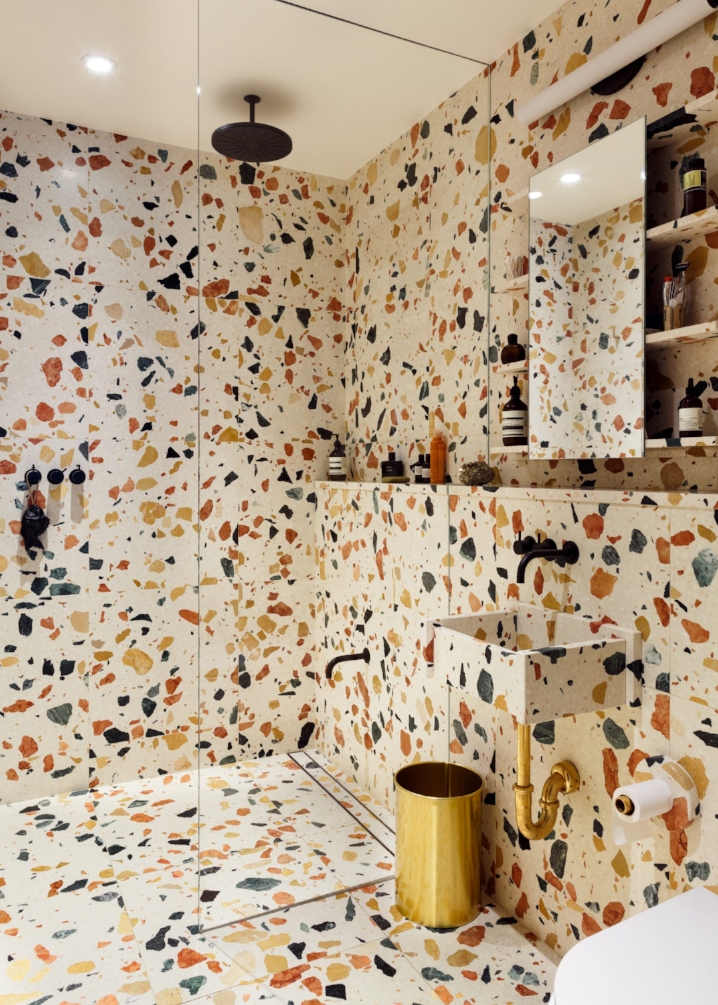Terrazzo is definitely having its moment. I say that because it is absolutely EVERYWHERE. I personally think that’s a good thing because I want to plaster my life in terrazzo. I can’t tell if it’s going to be one of those interior design trends that dies down and makes you wish you had never succumbed to it, mostly because it’s was an expensive investment, and now it looks so 2018. I can’t help but notice it wherever I go—for example at the San Francisco DMV today, which if taken out of the context of a building probably built in the late 1960s and ready for a revamp, looks amazing, especially with these brass spacers separating the terrazzo tiles. Can I then conclude terrazzo is timeless? Or is it a resurfacing trend like high-waisted jeans paired with crop tops?
Terrazzo floors with brass spacers at the San Francisco DMV, a surprising moment in an otherwise forgettable building.
I notice terrazzo everywhere I shop too. Just take these pieces from Anthropologie, The Citizenry and 1stdibs. It seems like everyone is jumping on the terrazzo bandwagon.
According to the National Terazzo and Mosaic Association (yes, that exists!), which was formed in 1924, terrazzo originated when 16th century Venetian mosaic workers found a way to use leftover marble as terrace flooring in their own homes. By reusing these marble remnants they unintentionally created an extremely durable and environmentally friendly flooring material that stands the test of time.
In the US, it was first installed in the Vanderbilt Residence in New York on 5th Avenue in 1890. Then in the early 1900s, after three million Italians immigrated to the US, it became a well-guarded trade secret, passed down from generation to generation. After World War I terrazzo flooring began to replace marble mosaic flooring, probably due to its lower cost and prevalent availability. Architects in the 1920s specified terrazzo to take advantage of its versatility and alignment with the style of the time, Art Deco. Many iconic buildings have terrazzo floors including Radio City Music Hall and the Guggenheim Museum, designed by Frank Lloyd Wright
This interesting article outlines terrazzo's history in more detail – pay attention to the note about goat milk (who would have thought)?!
http://ntma.com/wp-content/uploads/2015/06/History-of-Terrazzo.pdf
As a surface, you can literally use terrazzo anywhere—you can have terrazzo floors, terrazzo walls, terrazzo countertops. It is a very durable material to boot. I am particularly loving these kitchens and bathrooms, which allow the material to take center stage.
For an inexpensive terrazzo flooring fix take these Waterworks Concourse tiles, which come in a few different sizes. These tiles are surprisingly affordable and get the terrazzo look across beautifully.
Of course, the wonders of terrazzo are not limited to kitchens and bathrooms. They look great as floors in living spaces as well. This modern pad in Paris has a terrazzo "rug" surrounded by hardwood floor in the living room.
A Paris living room with terrazzo floors. Image Credit: Chiara Dal Canto/Living inside, Bo Bedre
For a more interesting approach, just about any pattern can be created out of different colors of the aggregate. Just look at the Taschen bookstore in Milan, which has whimsical patterns on their floors, or the Salvatori Milan showroom. The terrazzo interior design possibilities are endless!
For a ready-to-go terrazzo floor pattern, check out these terrazzo and concrete tiles from Ann Sacks, which come in a variety of designs.
For those of us on a budget and not looking to commit to a full on renovation, there are some less costly imitators to choose from—for example this wallpaper from Designer’s Guild, available through an interior designer.
If you are afraid of a commitment or renting like many San Franciscans are, take a look at these non-invasive types of terrazzo products that will satisfy your terrazzo craving and won't break the bank.
After learning of the history of terrazzo I have to conclude that it’s not just another interior design trend of the late “Twenty-tens”, but a resilient material incorporated throughout recent architectural history. So go ahead, terrazzo it up! #terrazzo





















